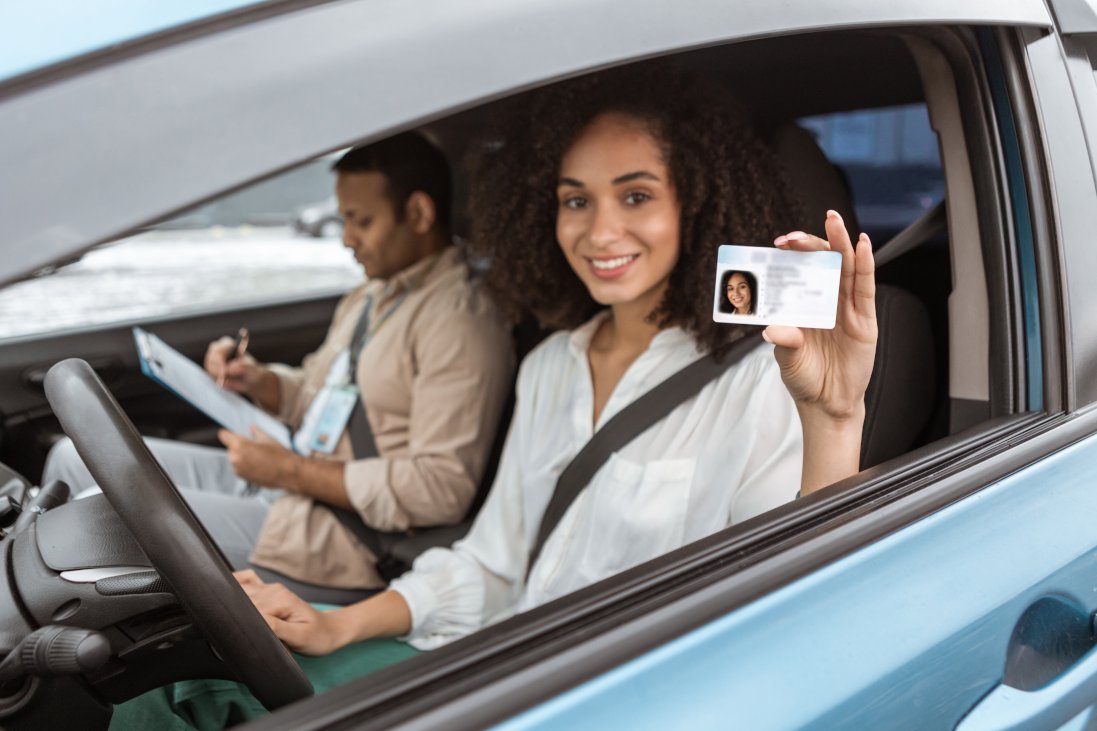Embarking on the journey to become a licensed driver is an exciting milestone, starting with beginner driving lessons. Yet, for many beginners, the path can seem strewn with obstacles—from mastering vehicle controls to understanding road signs.
With years of experience in guiding rookie drivers through this rite of passage, our approach demystifies the process and lays a solid foundation for safe and confident driving.
This ultimate guide serves as your roadmap, steering you away from common pitfalls while empowering you with essential knowledge and skills. Here’s an important fact: In Ontario alone, quality driver education has been proven to reduce collisions among new drivers significantly.
Ready to shift gears into your driving future? Let’s drive into the details.
Key Takeaways
- Beginner driving lessons provide essential knowledge and skills, increase confidence, and instill safe driving practices, helping new drivers navigate the roads with competence and responsibility.
- In – class instruction offers foundational knowledge and interactive learning sessions to familiarize new drivers with basic maneuvering techniques before practical training.
- Online courses are a flexible option for busy schedules, providing access to course materials from home and cost-effective simulations to practice decision-making behind the wheel.
- Individual lessons offer personalized attention to address specific areas of improvement, allowing learners to progress at their own pace and receive tailored feedback.
The Benefits of Beginner Driving Lessons
Beginner driving lessons offer new drivers the opportunity to gain knowledge and skills, increase confidence, and learn safe driving practices.
Gain knowledge and skills
Embarking on beginner driving lessons is a cornerstone in acquiring the necessary knowledge and skills essential for safe and effective driving. Every new driver starts by mastering the basics: understanding road signs, learning traffic laws, and operating the vehicle controls comfortably.
In Alberta’s learner-friendly environment, these initial steps are crucial in developing a foundation that supports more complex driving abilities like collision avoidance and defensive driving.
As students progress through their driver education course at an accredited driving school, they delve deeper into sophisticated techniques such as paddle shifting with a manual gearbox or maneuvering vehicles equipped with dual clutches.
Gaining proficiency in these areas doesn’t just prepare them for the practicalities of everyday driving; it empowers them to handle unexpected situations on the road efficiently, thus safeguarding themselves and others.
This transformative journey from novice to experienced motorist is vital for anyone aiming to obtain their drivers license – it’s not only about passing tests but also about fostering responsible habits that last a lifetime.
Increase confidence
Mastering the skills taught during beginner driving lessons directly feeds into a new driver’s confidence. With each in-car lesson, learner drivers become more familiar with the vehicle’s controls and how to interact with other road users, paving the way for safer and more assured driving experiences.
Certified instructors from schools like Young Drivers of Canada provide constructive feedback that helps students understand their progress and areas needing improvement.
As learners navigate various traffic scenarios under professional supervision, their ability to anticipate risks and handle potentially challenging situations improves. This kind of supportive learning environment helps transform anxious beginners into confident motorists ready for the ministry of transportation’s driver’s license test.
With enhanced confidence, teenagers in Alberta not only meet but often exceed service Ontario’s standards, leading them closer to personal freedom and independence on the road.
Learn safe driving practices
Safe driving practices are the cornerstone of any beginner driver education course. Through in-car lessons, students get hands-on experience with driving maneuvers, ensuring they’re ready for real-world situations.
As new drivers learn to understand their vehicle’s functions and controls, they also discover how to position themselves correctly on the road, leading to increased safety for everyone.
Drivers gain defensive driving skills that help them anticipate and react appropriately to traffic conditions and hazards. Driver training programs emphasize the importance of checking mirrors regularly, signaling intentions clearly, and being aware of other road users.
These valuable lessons help foster responsible driving habits that contribute to a lifetime of safe navigation on the roads—and could even lead to savings on auto insurance for smart-driving teens.
The Different Types of Beginner Driving Lessons
– In-class instruction provides hands-on experience and interaction with instructors and peers.
– Online courses offer flexibility for those with busy schedules and provide access to learning materials from the comfort of home.
– Individual lessons allow for personalized attention and tailored instruction to address specific areas of improvement.
In-class instruction
In-class instruction for beginner driving lessons provides foundational knowledge about how a vehicle works, safe positioning on the road, and essential driving practices. This type of instruction typically includes interactive learning sessions where students can ask questions and participate in discussions to deepen their understanding of the rules of the road.
In addition, many driving schools integrate light driving practice during in-class sessions to familiarize new drivers with basic maneuvering techniques before they hit the road for practical training.
The Ministry of Transportation in Ontario has introduced digital learning for the in-class portion of beginner driver education, making it more accessible and convenient for aspiring drivers.
Online courses
Online courses are an accessible and convenient option for beginner driving lessons. They provide the flexibility to learn at your own pace, fitting in with busy schedules. With internet access, learners can access course materials from the comfort of their homes, making it ideal for teenagers and new drivers seeking a hassle-free learning experience.
Online courses also offer interactive modules and videos to enhance understanding and retention of important driving skills and knowledge.
In addition to being cost-effective, online courses often include simulations to practice decision-making behind the wheel before hitting the road. Furthermore, they can be particularly beneficial for parents who wish to reinforce good driving practices with their children.
Individual lessons
Individual lessons offer tailored instruction to meet the specific needs of new drivers. These sessions provide focused attention, allowing learners to address their weaknesses and build on strengths.
With one-on-one guidance, students can progress at their own pace and receive personalized feedback, ultimately leading to a more comprehensive understanding of driving techniques.
In these individual lessons, instructors can cater to the unique learning styles and preferences of each student. This personalized approach fosters a supportive environment where individuals can ask questions freely and practice skills in a comfortable setting.
Finding the Right Driving School
Look for driving schools with accreditation, experienced instructors, and flexible scheduling. Reading more will help you make the right choice for your beginner driving lessons.
Accreditation and certifications
When choosing a driving school for beginner lessons, it is crucial to consider accreditation and certifications. Here are the essential factors to look for:
- Government-approved schools in Alberta provide standardized instruction, ensuring high-quality education and safety for new drivers.
- Accredited driving schools yield the advantage of enabling drivers to complete their road tests sooner, thus expediting the process of obtaining a driver’s license.
- Reputable organizations’ accreditations and certifications ensure that the driving school meets strict criteria for quality education and adherence to safety standards.
Experienced instructors
Experienced instructors play a vital role in shaping the driving skills and confidence of new drivers. They provide expert guidance, ensuring that learners understand the rules of the road and develop safe driving habits.
With their wealth of experience, these instructors offer personalized attention, constructive feedback, and effective teaching methods to help new drivers navigate various traffic scenarios.
Their expertise also extends to coaching on defensive driving techniques, equipping students with the necessary tools to anticipate and respond to potential hazards on the road.
In addition, experienced instructors are adept at creating a supportive learning environment for apprehensive or nervous drivers, fostering a sense of reassurance and encouragement as they progress through their lessons.
Flexible scheduling
Driving schools that offer flexible scheduling understand the busy lives of new drivers and their families. They provide options for both in-class and behind-the-wheel instruction at various times during the day, evening, or even weekends.
This allows young drivers to balance their education, extracurricular activities, and family commitments while still gaining essential driving skills. Flexible scheduling also enables parents to support their teenagers’ learning without drastically rearranging work schedules or other responsibilities.
Furthermore, by offering adaptable class timings, driving schools cater to adult learners who may be balancing a job with obtaining their driver’s license. This flexibility makes it easier for working adults to fit in lessons around their professional commitments without sacrificing valuable time or income.
Important Skills Covered in Beginner Driving Lessons
The important skills covered in beginner driving lessons include the cockpit drill (DSSSM), use of mirrors and signals, moving off and stopping, steering techniques, and gear changing.
These fundamental skills are essential for new drivers to develop safe and confident driving habits.
Cockpit drill (DSSSM)
Before hitting the road, new drivers need to familiarize themselves with the cockpit drill. This essential procedure, often referred to as DSSSM (Doors, Seat, Steering, Seatbelt, Mirrors), ensures that everything is in place for a safe and comfortable drive.
Firstly, check that all doors are closed securely. Next, adjust your seat and steering wheel to ensure a proper driving position. Then fasten your seatbelt securely and check your mirrors for optimal visibility before starting the engine.
Understanding the cockpit drill not only promotes safety but also sets a solid foundation for good driving habits from the beginning. By incorporating these simple steps into their routine, new drivers can establish a strong focus on safety awareness and attentiveness behind the wheel.
Use of mirrors and signals
Practice using your mirrors regularly when driving in traffic. Glance at them every 5 to 8 seconds to stay aware of your surroundings, a crucial aspect emphasized in beginner driving lessons.
Incorporating the use of mirrors into the cockpit drill (DSSSM) helps you develop good habits early on. Additionally, understanding that car signals are essential for communicating with other drivers ensures safer road experiences.
Remember, mastering the use of mirrors and signals is fundamental for becoming a confident and responsible driver.
Moving off and stopping
Beginner driving lessons emphasize the importance of mastering the skill of moving off and stopping. These skills are fundamental for a smooth and safe driving experience, ensuring that new drivers can transition on the road confidently.
In these lessons, students are taught to control acceleration and braking smoothly while paying close attention to speed limits and using signals effectively.
Being able to move off and stop seamlessly is crucial for maintaining safety on the road. New drivers learn essential techniques such as proper clutch control, footwork coordination, and maintaining appropriate distances from other vehicles in order to execute these maneuvers with precision.
Steering techniques
Correct steering techniques are crucial for new drivers to effectively control the vehicle. One important aspect covered in beginner driving lessons is learning the pull/push steering method, considered best practice for confidently navigating roads.
Mastering this technique ensures proper hand position and smooth handling of the steering wheel, promoting safe and controlled driving experiences. It’s essential for new drivers to grasp these fundamental skills early on to build a strong foundation for their future behind the wheel.
Understanding and implementing correct steering techniques not only enhances driving capability but also contributes to overall road safety. With focused practice, new drivers can gradually develop confidence and proficiency in maneuvering their vehicles with precision and control.
Gear changing
Practice gear changing until it becomes second nature. Smoothly shift gears by pressing the clutch pedal, moving the stick shift into the desired gear, and releasing the clutch gradually while maintaining a consistent speed.
Become proficient in this skill to ensure a seamless driving experience and minimize wear and tear on your vehicle’s transmission.
Start with an automatic vehicle if you’re unsure about manual gear shifting. This will help you focus on other essential driving skills before mastering manual gear changes. Remember to always be aware of your car’s recommended shift points to avoid damaging the engine or experiencing abrupt jolts while driving.
Additional Tips for New Drivers
Practice with a licensed driver to gain real-world experience and confidence behind the wheel. Familiarize yourself with road rules and signs, and avoid distractions while driving.
Consider taking a defensive driving course to further enhance your skills, and always stay calm and confident when navigating the roads.
Practice with a licensed driver
Practice with a licensed driver before going solo on the road. This hands-on experience provides valuable guidance and support, helping you gain confidence as you navigate different driving scenarios.
It also allows for real-time feedback from an experienced driver, facilitating your learning process. Additionally, practicing with a licensed driver helps familiarize you with local traffic laws and regulations, ensuring that you are prepared to handle various situations when behind the wheel.
By practicing under the supervision of a licensed driver, new drivers can learn essential defensive driving techniques and develop safe habits early on. This practical experience is crucial for honing your skills and building the foundation for becoming a responsible and competent driver.
Get familiar with road rules and signs
Familiarize yourself with road rules and signs to drive responsibly. Obey all traffic rules, from understanding various types of road signs to knowing right-of-way regulations. It is crucial for new drivers to have a good grasp of these fundamental aspects of driving.
Understanding road signs and rules will help you navigate the roads safely, making it essential knowledge for any new driver in Alberta.
Learn about the different types of road signs and what each one signifies. Pay attention to common road markings like stop lines, pedestrian crossings, and yield signs – understanding these will ensure that you are well-prepared when encountering them on the road.
Avoid distractions while driving
Eliminate distractions when driving. Keep your phone out of reach and avoid texting or calling while on the road. Adjust your music, GPS, and other settings before you start driving to avoid fiddling with them while in motion.
Engage in conversations with passengers only when it’s safe to do so. Remember that staying focused is crucial for your safety and the safety of others on the road.
Stay attentive by scanning the surroundings constantly. Check your mirrors, be aware of blind spots, and anticipate potential hazards on the road. Maintain a clear mind by avoiding eating, grooming, or any other activities that might divert your attention from driving.
Consider taking a defensive driving course
Enhance your driving skills and safety on the road by considering a defensive driving course. Whether you are a new driver or have been behind the wheel for some time, these courses offer valuable knowledge and techniques to help you navigate different scenarios with confidence.
With benefits ranging from improved driving abilities to potential insurance savings, taking a defensive driving course is a smart investment in your safety and that of others on the road.
Through these courses, drivers gain essential skills such as heightened awareness of their surroundings, self-reliance on the road, and adherence to critical rules like maintaining a safe following distance.
Stay calm and confident behind the wheel
Maintaining a calm and confident mindset while driving is essential for new drivers. By mentally preparing and focusing on positive experiences, anxiety and fear associated with driving can be overcome.
Encouragement from experienced coaches or licensed drivers also plays a crucial role in building confidence behind the wheel. Overcoming fear, staying focused, and regularly practicing basic skills covered in beginner driving lessons contribute to becoming a more confident and safe driver.
Having the right mental approach is just as important as mastering technical skills when it comes to new drivers gaining confidence on the road. Practicing positivity while learning to drive can significantly impact their overall experience behind the wheel.
Conclusion
Mastering beginner driving lessons equips new drivers with essential skills, fostering confidence and safety on the road. With the right school and guidance, beginners gain an understanding of their vehicle and crucial driving maneuvers.
Aspiring drivers are encouraged to practice regularly in varied conditions while upholding a proactive approach to road safety. Embracing these tips lays a strong foundation for safe and responsible driving habits, setting the stage for a lifetime of confident motoring.
FAQs
1. What do I need to start beginner driving lessons?
To start your driving lessons, you must have a valid identification such as a driver’s license or learner’s permit.
2. How do I get my driver’s licence?
You can get your driver’s licence by passing both the written and practical driving tests, which are usually taught during beginner driving lessons.
3. Will teachers be available for all my beginner driving sessions?
Yes, qualified teachers will guide you through each lesson ensuring you gain the skills necessary for safe and confident driving.
4. Can I use resources like Internet Explorer to study for my driver license test?
Sure! You can use any internet browser, including Internet Explorer, to access online materials that help prepare you for your driver license tests.






Comments are closed